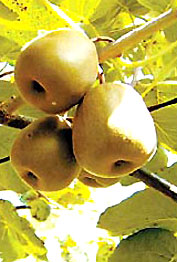Return of a not-so prodigal fruit to its land of origin
Updated: 2007-10-27 09:58
Call it a homecoming, if you will. A fruit the world associates with New Zealand because of its name is returning to its land of origin.
 Kiwifruit is ranked among the most nutritious fruits in the world. |
New seeds of change are being planted again. Only this time, the kiwifruit cultivars developed in New Zealand are returning to China.
New Zealand researchers believe China has great potential as a growing site for the fruit, and work is on to breed new kiwifruit cultivars from mihoutao.
New Zealand-based ZESPRI International, which runs the world's largest kiwifruit breeding and production program, is now pioneering the New Zealand-bred kiwifruit's return to its roots.
"As the natural home of most kiwifruit species, we believe China has strong potential to enhance its position as a producer of world-class kiwifruit, and we are eager to support the further growth of the Chinese industry," says ZESPRI's Chief Executive Tony Nowell.
"We seek partnerships with the best kiwifruit growers across the world and (want to) offer our marketing expertise to generate premium returns for those growers."
ZESPRI spends $5 million a year on kiwifruit breeding research and development and $15 million on production research.
Its most successful variety - Hort16A, marketed as ZESPRI Gold - is the first New Zealand-developed cultivar to return to China.
"Through this work, ZESPRI is starting to provide expertise and enhanced economic opportunities for a country with huge horticultural growth potential," Nowell says.
At present, only two varieties of commercially viable kiwifruit are traded globally - green and gold, he says. "But the number of varieties is increasing."
The process for creating a new cultivar - from conceptualization to the time it enters the market - takes more than a decade, though. A vine takes more than three years to fruit, and after a generation produces kiwifruit with the desired traits, the new variety must be monitored for three years for consistency.
One good thing is that ZESPRI doesn't use genetic modification in its breeding research. "Using only natural methods, the breeding program aims to develop new varieties of kiwifruit with exciting flesh colors, exceptional taste and consumer appeal, good shelf life, consistent high quality and good size," Nowell says.
New Zealand recently launched a NZ$19-million ($14.5 million) campaign to boost food and beverage export to China.
It exports 7.5 million kg, or NZ$15.97 million ($12.2 million) worth, of kiwifruit to China. Two years ago, New Zealand used to export less than half the quantity to China, according to the New Zealand Trade and Enterprise (NTZE).
Kiwifruit is New Zealand's sixth largest food and beverage F&B export and its fifth largest overall F&B export to China. The pitch to Chinese consumers is that New Zealand foodstuff production follows sustainable methods. They are healthy and of a high quality - "pure tastes from a pure place", as New Zealand Ambassador Tony Browne said at a recent luncheon announcing the campaign at the country's embassy in Beijing.
If healthy food is the pitch, the kiwi fruit is a premium product to push. In 1992, the Center for Science in the Public Interest ranked kiwifruit among the top 10 most nutritious fruits.
A California Kiwifruit Commission report has said: "Nutritional studies revealed that kiwifruit is the most 'nutrient dense' of all major fruits.
|
|
|
||
|
||
|
|
|
|